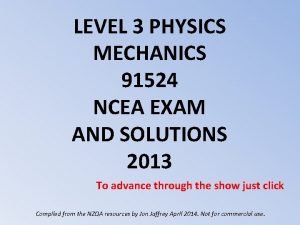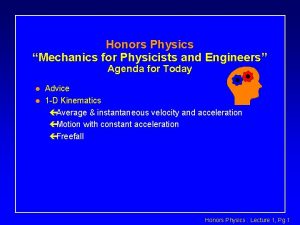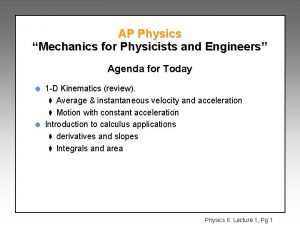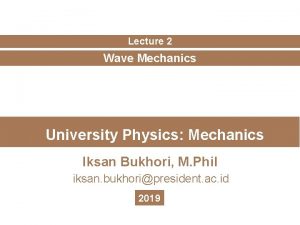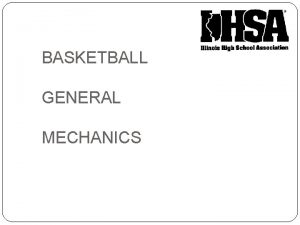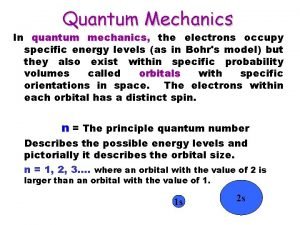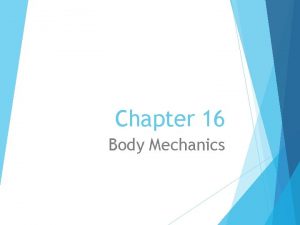Physics I Lecture 1 Mechanics for Physicists and











- Slides: 11

Physics I: Lecture 1 “Mechanics for Physicists and Engineers” Agenda for Today Advice Scope of this course Measurement and Units Fundamental units Systems of units Converting between systems of units Dimensional Analysis Honors Physics : Lecture 1, Pg 1

Course Info & Advice l çBe prepared and be organized Course has several components: çLecture (me talking, demos and Active learning). çDiscussion sections (group problem solving). çLabs (group exploration of physical phenomena). Honors Physics : Lecture 1, Pg 2

Lecture Organization l Three main components: çLecturer discusses class material çThese notes are intentionally incomplete, and should be complete during lecture or by using text, library, and webpages » Follows lecture notes very closely » Not much work, just incentive to attend class, go over examples and problems. çLecturer does as many demos as possible » If you see it you gotta believe it ! çStudents work in groups on conceptual “Active Learning” problems. » Usually twice per lecture Honors Physics : Lecture 1, Pg 3

Scope of Physics l l l Classical Mechanics Heat & Thermodynamics Wave Behavior Electromagnetism Nuclear Honors Physics : Lecture 1, Pg 4

See text : 2. 1 Units l l How we measure things! All things can be expressed in terms of the fundamental units: çLength çMass çTime l L M T For example: çSpeed has units of L / T (i. e. miles per hour). çForce has units of ML / T 2 etc. . . (as you will learn). Honors Physics : Lecture 1, Pg 5

Units. . . l Rational Units: çmks: L = meters (m), M = kilograms (kg), T = seconds (s) çcgs: L = centimeters (cm), M = grams (gm), T = seconds (s) l Irrational Units: çFeet, pounds, slugs. . . çpretty much anything 'non metric'. l We will use mostly rational units, but you may run across some problems using irrational units. You should know how to convert back & forth. Honors Physics : Lecture 1, Pg 6

Length: Distance To Andromeda Galaxy To nearest star Earth to Sun Radius of Earth Football Field Tall person Thickness of paper Wavelength of blue light Diameter of hydrogen atom Diameter of proton Length (m) 2 x 1022 4 x 1016 1. 5 x 1011 6. 4 x 106 1. 0 x 102 2 x 100 1 x 10 -4 4 x 10 -7 1 x 10 -10 1 x 10 -15 Honors Physics : Lecture 1, Pg 7

Time: Interval Age of Universe Age of Grand Canyon My age One year One hour Light travel from Earth to Moon One cycle of guitar A string One cycle of FM radio wave Lifetime of neutral pi meson Lifetime of top quark Time (s) 5 x 1017 3 x 1014 1. 1 x 109 3. 2 x 107 3. 6 x 103 1. 3 x 100 2 x 10 -3 6 x 10 -8 1 x 10 -16 1 x 10 -22 Honors Physics : Lecture 1, Pg 8

Mass: Object Milky Way galaxy Sun Earth Boeing 747 Car Student Dust particle Copper atom Proton Electron Mass (kg) 2 x 1041 2 x 1030 6 x 1024 2 x 106 1 x 103 7. 5 x 101 1 x 10 -9 1 x 10 -23 2 x 10 -27 9 x 10 -31 Honors Physics : Lecture 1, Pg 9

See text : 2. 1 Converting between different systems of units l Useful Conversion factors: ç 1 m = 3. 28 ft ç 1 kg = 0. 069 slug ç 1 inch = 2. 54 cm ç 1 mile = 5280 ft l Example: convert miles per hour to meters per second: Honors Physics : Lecture 1, Pg 10

See text : 2. 2 Significant Figures l l l When multiplying or dividing, the answer should have the same number of significant figures as the least accurate of the quantities in the calculation. When adding or subtracting, the number of digits to the right of the decimal point should equal that of the term in the sum or difference that has the smallest number of digits to the right of the decimal point. Examples: ç 0. 031 2 sig figs ç 3. 030 4 sig figs ç 2 1 sig fig ç. 031 * 3. 030=. 094 2 SIG FIGS 2 * 0. 031=. 06 1 Sig fig ç 0. 03 + 3. 030= 3. 06 Hundredths 2+ 0. 031= 2 Ones Honors Physics : Lecture 1, Pg 11
 International young physicists' tournament
International young physicists' tournament Matthews parents are physicists
Matthews parents are physicists 01:640:244 lecture notes - lecture 15: plat, idah, farad
01:640:244 lecture notes - lecture 15: plat, idah, farad Physics 111 lecture notes
Physics 111 lecture notes What is a harmonic wave in physics
What is a harmonic wave in physics Physics 101 lecture 1
Physics 101 lecture 1 Physics 101 lecture notes pdf
Physics 101 lecture notes pdf Waves 1 physics notes
Waves 1 physics notes Atmospheric physics lecture notes
Atmospheric physics lecture notes Classical mechanics
Classical mechanics Beta decay
Beta decay Ncea level 3 mechanics formula sheet
Ncea level 3 mechanics formula sheet











